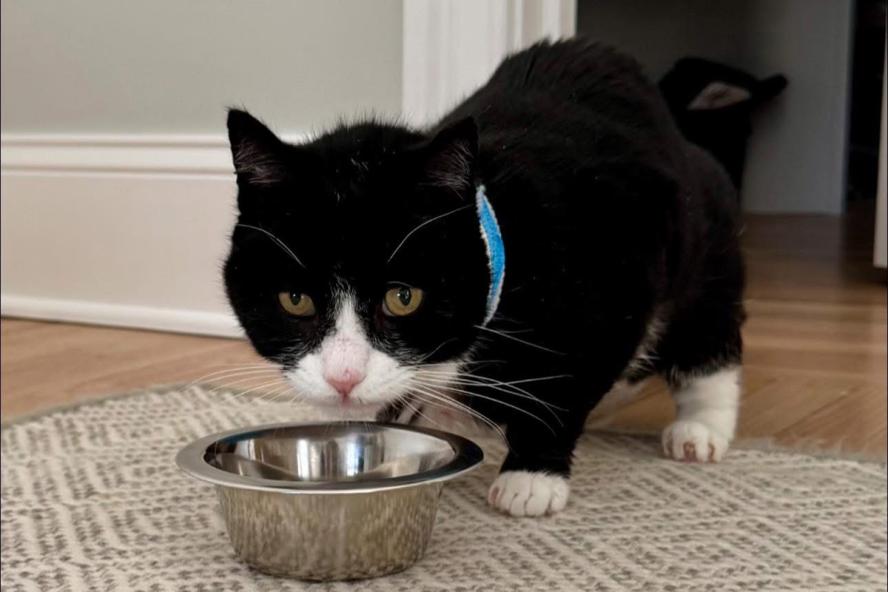The Emergency Medicine and Critical Care (ECC) team at FHSA stabilized Sassy and immediately called in the cardiology service. Dr. Hannah Melhorn, cardiology resident in the Department of Clinical Sciences at Cummings School, performed an echocardiogram to confirm the diagnosis of caval syndrome. Heartworms were entrapped in one of the heart valves (the tricuspid valve), obstructing blood flow and causing hemolysis, the destruction of his red blood cells. He also had fluid buildup in his chest and abdomen, consistent with congestive heart failure.
“Caval syndrome is a medical emergency,” says Chi. “It requires urgent intervention. The animal gets very sick, and they won’t do well unless you physically extract the worms out of the heart. It’s a procedure with a high risk for mortality and major complications.”
Heartworms are thin and long (some reaching up to 30 centimeters) and can intertwine with one another and form a worm mass in the heart, as in Sassy’s case. While heartworm extraction held a 50 percent risk of the cat passing away during surgery, Melhorn explained to Pepe that Sassy would not live long with caval syndrome.
“I knew that if we did nothing, he would die. We always do what we can if there’s a chance the cat can be okay, and this case was a perfect example. I knew it could go wrong, and there was a chance it would go right. In Sassy’s case, it went right, and I’m happy that we made that decision,” says Pepe. Surgery was scheduled early the following morning.
Chi and Melhorn worked in tandem to snare and extract the worms from Sassy’s heart. They made an incision into the jugular vein in his neck to pass a special catheter into the heart. The catheter has a snare, which Chi describes as similar to a lasso, to pull out the worms. They caught a worm on their first try and delicately extracted it. After two unsuccessful attempts to hook another, they switched to a different snare and gingerly extracted the last two heartworms.
“When you try to grab the worms, you need to be extremely gentle. If you’re not gentle enough and break the worm with the snare or forceps, it will induce anaphylactic shock within seconds, and the animal can pass away from this complication. You have to be very, very gentle,” says Chi.
Key to their success was the help of cardiology resident Dr. Allison Mosichuk and veterinary technician Alyssa Luce. Heartworms are not visible on X-ray, so Mosichuk utilized a transesophageal ultrasound probe that passes through the esophagus and sits on top of the heart for close-up imaging, unobstructed by the rib cage. With Mosichuk guiding the probe, Chi and Melhorn had a visual of the worms as they retrieved them from Sassy’s heart.
“That helped us tremendously,” says Chi. “It was a high-risk situation and procedure going in, but we were able to pull it off. Sassy woke up beautifully, too, almost right away, and ten minutes later, he started eating food. He was a champion. A lot went well because of the cat. Sassy had a strong will to live.”
Sassy was discharged the following day. He recovered smoothly, though the heartworms did leave some lasting damage to his heart.
“He will have some degree of congestive heart failure going forward. Getting him off the table was a big success, but it’s not curable,” says Melhorn. “It takes a pretty hardy cat to make it through caval syndrome. The combination of a hardy cat, a dedicated shelter, and excellent teamwork, we got a good outcome.”
On her first experience taking a rescue animal to FHSA, Pepe says she gave the hospital a five-star rating on Google and adds, “The doctors made it so easy to talk to them—answered all of our questions and explained everything. Whenever we have a tough case like this, we’ll be coming back.”
Sassy has since been adopted and is now settled into his new home with a family in Connecticut.
“With surgical success in cats with caval syndrome being hard to achieve, this outcome was a big win for the Tufts team [Cummings School],” says Melhorn.
